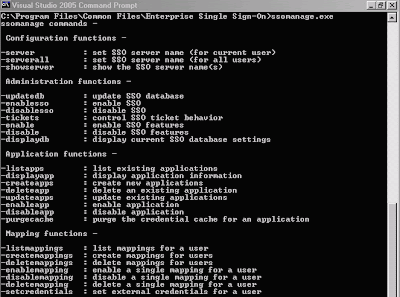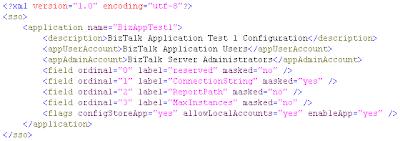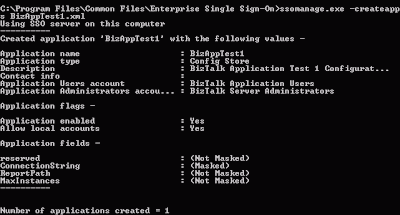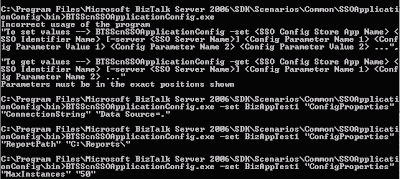There are at least 4 repositories where we can store the configuration for BizTalk orchestration :
- Custom config file
- BizTalk config file
- Windows Registry
- Database
Each repository above has its own pros and cons to implement, but I would say that configuration files and registry will not scale for MultiServer / Clustering environment, since we need to replicate them to each of the BizTalk server. So it will be easier to use database since we can put the configuration information in one place and all the servers will access this central database.
But when it comes to the database, we will have the next question of where to store the connection string. Well, this is the point where SSODB comes in handy.
As we may notice, whenever we install BizTalk Server, the Enterprise Single Sign-on will need to be installed as well, and the Enterprise Single Sign-on has a database, named SSODB. This is mainly used for BizTalk to store all the internal configuration information.
This SSODB will be the ideal solution for the configuration repository since as far as i know.
Benefits :
- SSO will be installed and running along with BizTalk server
- It provides encryption
- It provides a central configuration repository for multi server environment
How to configure our application configuration in SSODB
The SSO Installation comes some executable files in folder at C:\Program Files\Common Files\Enterprise Single Sign-On.
The executable which we're going to use is ssomanage.exe
 As you can see in the screen shot above, there are some paramaters we can pass into the ssomanage.exe.
As you can see in the screen shot above, there are some paramaters we can pass into the ssomanage.exe.To create our custom application configuration :
1. Define our custom application configuration definition xml (below)
 Note :
Note :- When defining the fields, notice that the 1st field (ordinal=0) is a reserved field, so do not define any of your field in here, start defining our custom fields from the 2nd field (ordinal=1) afterwards.
- Use masked=true attribute to fields which need more security.
2. Save into xml file, e.g. BizAppTest1.xml
3. Run ssomanage.exe -createapps BizAppTest1.xml
 4. Go to C:\Program Files\Microsoft BizTalk Server 2006\SDK\Scenarios\Common\SSOApplicationConfig
4. Go to C:\Program Files\Microsoft BizTalk Server 2006\SDK\Scenarios\Common\SSOApplicationConfig5. Run Setup.bat to compile the tool, the executables should be generated in the bin folder (BTSScnSSOApplicationConfig.exe)
6. Use this tool to define our fields value :
 Example :
Example :BTSScnSSOApplicationConfig.exe -set BizAppTest1 "ConfigProperties" "ConnectionString" "Data Source=."
Note : Use "ConfigProperties" for the SSOIndentifierName parameter
7. Verify whether the value is correct
 Example :
Example :BTSScnSSOApplicationConfig.exe -get BizAppTest1 "ConfigProperties" "MaxInstances"
Richard Seroter has created his own awesome SSO Config Store Application Manager as window client tool to do the configuration in SSODB. You may want to take a look at it and try it yourself. He also has a lot of great biztalk posts and bits ;)
Note : If you have any additional fields or you want to remove the fields from SSO, the only way i know right now is to delete the app (ssomanage.exe -deleteapp BizAppTest1) and then re-do all the steps to setup the configuration. I created some script in a batch file so it will be much easier to do and can be re-used for deployment to production as well.
How to retrieve the configuration from SSODB
Fear not, when we install the enterprise single-sign on, there is an installed interface component which will provide the functionality to access the SSODB database, so we don't need to take care about how and where to connect to the SSODB database.
After you download the BizTalk Sample file for SSO As configuration store http://go.microsoft.com/fwlink/?LinkId=99741, there is a utility cs file, named SSOConfigHelper.cs. You can either include this class or the dll into your project.
Then we can retrieve our custom configuration value by calling this static method from the SSOConfigHelper class :
Microsoft.SSO.Utility.SSOConfigHelper.Read("BizAppTest1", "ConnectionString");
Hope this helps :)
thanks for sharing this informative blog. SAP CRM is used for maintaining and managing relationship with customers by firm..
ReplyDeleteMicrosoft Windows Azure Training | Online Course | Certification in chennai | Microsoft Windows Azure Training | Online Course | Certification in bangalore | Microsoft Windows Azure Training | Online Course | Certification in hyderabad | Microsoft Windows Azure Training | Online Course | Certification in pune
ETL Testing online training
ReplyDeleteHadoop online training
Tibco online training
instagram takipçi satın al
ReplyDeleteinstagram takipçi satın al
takipçi satın al
instagram takipçi satın al
takipçi satın al
aşk kitapları
tiktok takipçi satın al
instagram beğeni satın al
youtube abone satın al
twitter takipçi satın al
tiktok beğeni satın al
tiktok izlenme satın al
twitter takipçi satın al
tiktok takipçi satın al
youtube abone satın al
tiktok beğeni satın al
instagram beğeni satın al
trend topic satın al
trend topic satın al
youtube abone satın al
beğeni satın al
tiktok izlenme satın al
sms onay
youtube izlenme satın al
tiktok beğeni satın al
sms onay
sms onay
perde modelleri
instagram takipçi satın al
takipçi satın al
tiktok jeton hilesi
pubg uc satın al
You can make a video for youtube how to do it. From this site https://soclikes.com you can get likes and views for your video
ReplyDeleteSo interesting article. Thanks to author for it! I advice you to post this article in Instagramk so that many interested people can see it. And you can always use the services of https://viplikes.net/ to increase the number of followers.
ReplyDeleteuşak eskort
ReplyDeletekilis eskort
osmaniye eskort
siirt eskort
muş eskort
bartın eskort
sivas eskort
şile eskort
ayvalık eskort
sultangazi eskort
alanya eskort
ReplyDeleteafyon eskort
amasya eskort
bayburt eskort
yozgat eskort
ataköy eskort
düzce masöz
manisa masöz
izmit masöz
görükle masöz
mmorpg
ReplyDeleteİnstagram Takipci Satın Al
tiktok jeton hilesi
Tiktok jeton hilesi
antalya sac ekimi
referans kimliği nedir
instagram takipçi satın al
mt2 pvp serverler
INSTAGRAM TAKİPCİ
Yeni perde modelleri
ReplyDeleteNumara onay
Turkcell Mobil Ödeme Bozdurma
Nft Nasil Alınır
Ankara Evden Eve Nakliyat
TRAFİK SİGORTASİ
dedektör
web sitesi kurma
aşk kitapları
smm panel
ReplyDeleteSMM PANEL
İS İLANLARİ
instagram takipçi satın al
HİRDAVATCİ
Www.beyazesyateknikservisi.com.tr
servis
tiktok jeton hilesi
minecraft premium
ReplyDeleteen son çıkan perde modelleri
nft nasıl alınır
en son çıkan perde modelleri
özel ambulans
lisans satın al
yurtdışı kargo
uc satın al
Good content. You write beautiful things.
ReplyDeletesportsbet
taksi
korsan taksi
vbet
mrbahis
hacklink
vbet
sportsbet
hacklink
Good text Write good content success. Thank you
ReplyDeletebonus veren siteler
mobil ödeme bahis
tipobet
betpark
kralbet
slot siteleri
betmatik
kibris bahis siteleri
başakşehir
ReplyDeletebayrampaşa
beşiktaş
beykoz
beylikdüzü
EXZD2
bitlis
ReplyDeleteedirne
hatay
ağrı
urfa
MXGF7G
Thanks for shareing comments
ReplyDeleteشركة تنظيف مكيفات بالقطيف
ReplyDeleteشركة تنظيف مكيفات
شركة صيانة و تمديد الصرف الصحي
ReplyDeleteصيانة و تمديد الصرف الصحي
شركة سنترالات بالقصيم
ReplyDeleteشركة سنترالات
I truly enjoy looking through on this web site , it holds superb content .
ReplyDeleteشركة تنظيف مسابح بالاحساء
ReplyDeleteشركة تنظيف خزانات بالرياض
شركة تنظيف مسابح بالرياض
glassagram
ReplyDeleteallsmo
instagram gizli hesap görme
revelio
bestwhozi
UDX
شركة كشف تسربات المياه بالرياض
ReplyDeleteشركة تسليك مجارى بالرياض
cfbfghfghgfhjgghj
ReplyDeleteشركة صيانة افران بالمدينة المنورة
شراء اثاث مستعمل بالرياض SaWFL2FU6G
ReplyDeleteشركة مكافحة النمل الابيض بالاحساء waurEposJT
ReplyDeleteشركة كشف تسربات المياه بالاحساء E2eiRQzOFv
ReplyDeleteشركة تنظيف مساجد بالجبيل
ReplyDeletekXuRuT4EWt6
شركة مكافحة بق الفراش بالدمام zzvbNf6yH4
ReplyDeleteشركة تنظيف مكيفات بالاحساء
ReplyDeleteR9Y83VAcl6